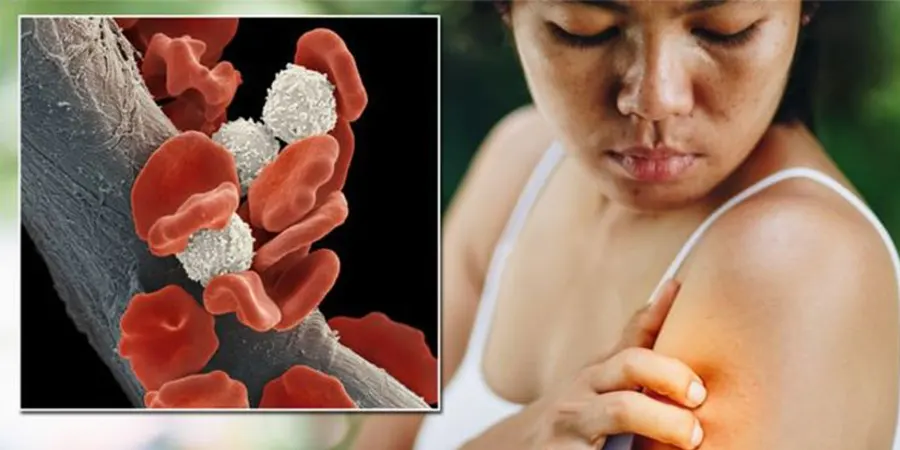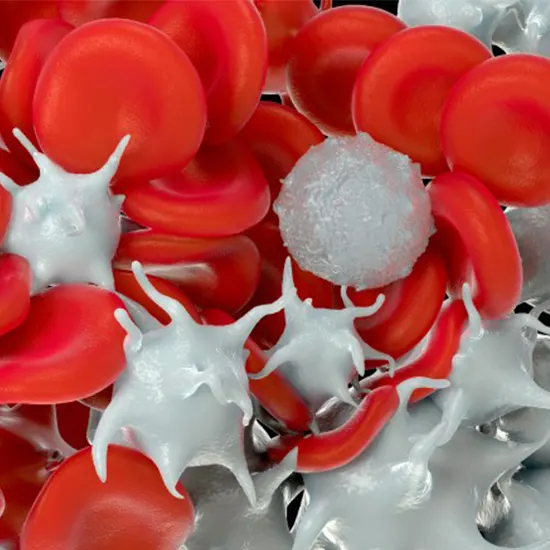
Blood cancer, also known as hematologic cancer, is a type of cancer that starts in the blood-forming cells in the bone marrow. These cells divide and mature into various types of blood cells, including white blood cells, red...
Blood cancer, also known as hematologic cancer, is a type of cancer that starts in the blood-forming cells in the bone marrow. These cells divide and mature into various types of blood cells, including white blood cells, red blood cells, and platelets.
There are several types of blood cancer such as:
- Leukemia
- Lymphoma
- Myeloma
Leukemia is a cancer of the blood and bone marrow, in which abnormal white blood cells are produced and invades other tissues.
Lymphoma is a lymphatic system cancer. The lymphatic system cancer includes the lymph nodes, spleen, and other organs.
Myeloma is a plasma cells cancer. Plasma cells are a white blood cell that produces antibodies.
Symptoms of blood cancer may include fatigue, fever, weight loss, bone pain, and enlarged lymph nodes.
Types of blood cancer
Leukemia: Leukemia is a type of blood cancer that starts in the bone marrow, where new blood cells are produced. It affects white blood cells and causes them to grow abnormally and rapidly, crowding out healthy cells in the bone marrow and interfering with normal blood cell production.
Subtypes of leukemia
- Acute lymphoblastic leukemia (ALL)
- Acute myeloid leukemia (AML)
- Chronic lymphocytic leukemia (CLL)
- Chronic myeloid leukemia (CML)
Lymphoma: Lymphoma is cancer that starts in the lymphatic system, which is part of the body's immune system. It affects lymphocytes, a type of white blood cell that helps fight infection. Lymphoma can occur in the lymph nodes, spleen, bone marrow, and other organs.
Two main types of lymphoma
- Hodgkin lymphoma
- Non-Hodgkin lymphoma
Myeloma: Myeloma is a type of cancer that starts in plasma cells, which are a type of white blood cell that produces antibodies. Myeloma cells accumulate in the bone marrow and interfere with the production of normal blood cells. This can cause anemia, infections, and bone pain.
Myelodysplastic syndromes (MDS): It is a group of disorders. In this disorder, the bone marrow is unable to produce enough health blood cells. It can lead to different medical conditions such as: anemia, infections, and bleeding. MDS can sometimes progress to acute leukemia.
Myeloproliferative neoplasms (MPNs): In this the bone marrow produces the blood cells in high quantity. This can cause the blood to thicken and increase the risk of blood clots. This disorder includes polycythaemia vera, myelofibrosis and essential thrombocythemia.
Stages of Blood Cancer
The staging of blood cancer depends on the specific type of cancer. In general, the staging system for blood cancers is based on the extent of the disease and the spread of the cancer cells.

The following are the stages of some of the most common types of blood cancer:
Leukemia: The staging system for leukemia is based on the subtype and the percentage of abnormal cells in the bone marrow and blood. The stages range from 0 (low-risk) to IV (high-risk).
Lymphoma: The staging system for lymphoma is based on the size and location of the lymph nodes involved, as well as the spread of cancer to other organs. The stages range from I (localized disease) to IV (widespread disease).
Myeloma: The staging system for myeloma is based on the level of abnormal proteins in the blood, the amount of calcium in the blood, the number of bone lesions, and the presence of kidney problems. The stages range from I (low-risk) to III (high-risk).
Myelodysplastic syndromes (MDS): The staging of MDS is based on the percentage of blasts (immature blood cells) in the bone marrow and the presence of cytogenetic abnormalities. The stages range from low-risk to high-risk.
Myeloproliferative neoplasms (MPNs): The staging of MPNs is based on the risk of blood clots, the size of the spleen, and the number of platelets in the blood. The stages range from low-risk to high-risk.
Symptoms of Blood Cancer
The symptoms of blood cancer can vary depending on the specific type of cancer and the stage of the disease.
The symptoms of blood cancer include:
Fatigue: Feeling tired and weak is a common symptom of blood cancer. This can be caused by anemia, a low red blood cell count, or cancer itself.
Fever: A persistent fever that does not go away with normal treatment can be a sign of blood cancer.
Unexplained weight loss: Losing weight without trying can be a symptom of blood cancer.
Enlarged lymph nodes: Swollen lymph nodes, usually in the neck, armpits, or groin, can be a symptom of blood cancer.
Night sweats: Drenching night sweats that soak through the bed sheets and clothing can be a symptom of blood cancer.
Bone pain: Pain in the bones, especially in the back, ribs, and hips, can be a symptom of blood cancer.
Bruising and bleeding: Easy bruising, bleeding, or prolonged bleeding can be a symptom of blood cancer.
Shortness of breath: Difficulty breathing or shortness of breath can be a symptom of blood cancer, especially if there is anemia.
Causes of Blood Cancer
Certain risk factors can increase a person's chances of developing blood cancer. These risk factors include:
Genetic mutations: Some people are born with genetic mutations that increase their risk of developing blood cancer. For example, people with Down syndrome have a higher risk of developing leukemia.
Exposure to certain chemicals: Exposure to certain chemicals, such as benzene, can increase the risk of developing blood cancer.
Radiation exposure: Exposure to high levels of radiation, such as radiation therapy for cancer, can increase the risk of developing blood cancer.
Certain infections: Some viral infections, such as the Epstein-Barr virus and human T-cell leukemia virus type 1 (HTLV-1), can increase the risk of developing blood cancer.
Age: The risk of developing blood cancer increases with age, with most cases diagnosed in people over 60 years old.
Family history: Having a family member with blood cancer, especially a first-degree relative, can increase the risk of developing blood cancer.
Immune system disorders: Certain immune system disorders, such as HIV/AIDS and autoimmune diseases, can increase the risk of developing blood cancer.
Prevention of Blood Cancer
There are some steps that can help reduce the risk of developing the disease. These steps include:
Avoid exposure to chemicals: Exposure to certain chemicals, such as benzene, has been linked to an increased risk of developing blood cancer. It's important to avoid exposure to these chemicals, when possible, especially in the workplace.
Protect yourself from radiation: Radiation exposure has also been linked to an increased risk of blood cancer. If you work in an environment where you may be exposed to high levels of radiation, make sure to take appropriate precautions to protect yourself.
Practice good hygiene: Some viral infections, such as the Epstein-Barr virus, have been linked to an increased risk of blood cancer. So, practice good hygiene such as: wash your hands regularly to reduce your infection risk.
Maintain a healthy lifestyle: Eating a healthy diet, exercising regularly, and maintaining a healthy weight can help reduce your risk of developing many types of cancer, including blood cancer.
Get regular check-ups: Regular check-ups with your healthcare provider can help detect blood cancer early, when it is most treatable.
Know your family history: If you have a family member with blood cancer, especially a first-degree relative, you may be at an increased risk of developing the disease. Knowing your family history can help you and your healthcare provider make informed decisions about your risk and any steps you can take to reduce it.
Diagnosis of Blood Cancer
The diagnosis of blood cancer involves several steps, including:
Medical history and physical examination: The healthcare provider will ask about your medical history and any symptoms you may be experiencing, as well as perform a physical examination.
Blood tests: Blood tests such as CBC, LFT, and KFT can be used to check for abnormal blood cell counts or other signs of blood cancer.
Bone marrow aspiration and biopsy: In a bone marrow biopsy and aspiration, a small sample of bone marrow is removed and examined under a microscope to look for signs of cancer.
Imaging tests: Imaging tests, such as ECG, and whole body pet scan, may be used to check for signs of cancer in other parts of the body.
Biopsy of lymph nodes or other tissues: If imaging tests show signs of cancer in lymph nodes or other tissues, a biopsy may be done to confirm the diagnosis.
Molecular testing: Molecular testing such as Immunophenotyping by Flow Cytometry, AML Categorization PCR, etc. can help identify specific genetic mutations or other changes that may be present in cancer cells.
The specific tests used to diagnose blood cancer can vary depending on the type of cancer suspected and other factors, such as the person's age and overall health. It's important to work with a healthcare provider who has experience in diagnosing and treating blood cancer.
Conclusion
Blood cancer is a complex and often a serious condition that affects the blood, bone marrow, or lymphatic system. Different types of blood cancer include: leukemia, lymphoma, and myeloma. Symptoms of blood cancer can vary depending on the type of cancer but may include fatigue, fever, and unexplained weight loss.
Certain risk factors, such as exposure to chemicals and radiation, may increase a person's risk of developing the disease. There is no guaranteed way to prevent blood cancer, but steps such as avoiding exposure to chemicals, protecting oneself from radiation, practicing good hygiene, and maintaining a healthy lifestyle may help reduce the risk.
Ganesh Diagnostic offers a blood cancer screening package for the early detection and diagnosis of blood cancer. It is important for improving treatment options, increasing the chances of remission and survival, reducing the risk of complications, and improving quality of life.















